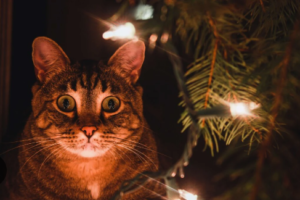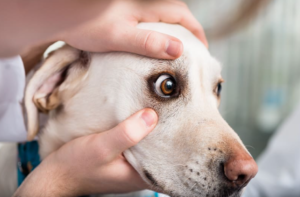If you’ve ever wondered whether your pet can see in the dark, you’re not alone! Many pet owners are curious about how well their furry friends can navigate at night. The answer? Yes, most pets have better night vision than humans, but their ability varies depending on the species. In this article, we will explore the fascinating science behind pet night vision, compare different pets’ abilities, and provide practical tips to support your pet’s eyesight.
How Does Pet See in the Dark?

You may love this post also: 11 Friendly Facts About Labrador Retrievers
Most pets, especially cats and dogs, have evolved to see better in low-light conditions. Their eyes have adapted in various ways to help them detect movement and navigate effectively at night. Below are some key reasons why your pet might see better in the dark than you do:
1. The Tapetum Lucidum: A Built-in Night Vision Enhancer
Your pet’s eyes contain a special reflective layer behind the retina known as the tapetum lucidum. This layer helps to amplify light by reflecting it back through the retina, giving the eye a second opportunity to absorb it. This feature is why your pet’s eyes may appear to glow in the dark when exposed to light. The tapetum lucidum significantly enhances their ability to see in dim conditions, making them much more adept at navigating at night compared to humans.
2. More Rod Cells for Better Light Sensitivity
The retina contains two types of photoreceptor cells: rods and cones. Rod cells are responsible for detecting light levels and motion, while cones are responsible for color vision and sharpness. Pets have a much higher number of rod cells compared to humans, allowing them to perceive movement and shapes in low-light environments. This adaptation is particularly useful for nocturnal hunters like cats.
3. Wide Pupils for Maximum Light Intake
Pets can dilate their pupils significantly to let in more light when necessary. A wider pupil means more light is absorbed, which helps in darker conditions. Cats, for example, can adjust their pupil size dramatically depending on the amount of available light. This ability allows them to see with much greater clarity in dim conditions than we can.
How Well Can Different Pets See in the Dark?

Not all pets have the same level of night vision. Some rely on it heavily, while others use different senses to navigate in the dark. Here’s a closer look at how various common pets perform in low-light environments:
1. Cats: The Ultimate Night Hunters
Cats are known for their exceptional night vision, which is nearly six times better than that of humans. Their eyes are highly sensitive to even the smallest amount of light, making them effective hunters in near-total darkness. The combination of a well-developed tapetum lucidum, a high rod-to-cone ratio, and the ability to contract or expand their pupils dramatically makes them the ultimate nocturnal navigators.
2. Dogs: Good, but Not as Sharp as Cats
Dogs also have good night vision, though not as advanced as cats. They still possess the tapetum lucidum and an increased number of rod cells, allowing them to see better in dim light than humans. However, their vision is not as sharp in darkness as their feline counterparts. Dogs rely more on their sense of smell and hearing in low-light conditions.
3. Rabbits: Better Than Humans, but Still Limited
Rabbits are crepuscular animals, meaning they are most active during dawn and dusk. Their eyes are adapted to detect movement in low-light conditions, but their night vision is not as strong as that of cats or dogs. Instead, rabbits depend on their acute sense of hearing and their ability to detect motion quickly to avoid predators.
4. Birds: Nocturnal Species Have Superior Vision
While many birds are diurnal and have poor night vision, nocturnal birds like owls have some of the best low-light vision in the animal kingdom. Their eyes are specifically adapted to capture as much light as possible, and their brains process visual information exceptionally well in darkness.
5. Reptiles & Fish: Unique Adaptations
Some reptiles, such as geckos, have excellent night vision due to specialized eye structures. Many fish, particularly those that live in deep waters, have developed ways to see in near-total darkness by detecting bioluminescent light or using other sensory adaptations.
Should You Leave a Light on for Your Pet at Night?

Most pets don’t need a nightlight, but it depends on their individual needs. Here are some factors to consider:
- Older pets: If your pet is aging or has vision issues, a small nightlight may help them navigate more easily.
- Anxious pets: Some animals feel more secure with a dim light, especially if they experience separation anxiety.
- New environments: If you’ve recently moved or rearranged furniture, a nightlight can help prevent confusion and accidents.
For most pets, their enhanced night vision means they don’t require artificial lighting to move around comfortably in the dark.
Signs Your Pet Might Have Vision Problems

Even though pets have great night vision, they can still develop eyesight issues. Keep an eye out for these warning signs:
- Frequently bumping into furniture or walls.
- Hesitation or fear when entering dark rooms.
- Cloudy or hazy eyes.
- Excessive squinting or blinking.
- Changes in activity levels, such as reluctance to move at night.
If you notice any of these symptoms, consult a veterinarian for an eye health checkup. Early detection can help manage potential issues before they worsen.
Final Thoughts: Can My Pet See in the Dark?
Yes, most pets have some level of night vision, but the extent varies by species. Cats have the best night vision among domestic animals, while dogs, rabbits, and some birds also have enhanced low-light capabilities. Understanding how your pet sees in different lighting conditions can help you create a safer and more comfortable environment for them.
By appreciating your pet’s unique visual abilities, you can ensure they lead a happy, healthy life. Want to learn more about pet health and behavior? Explore our other articles for expert advice and insights!
